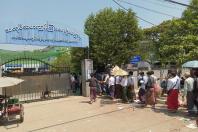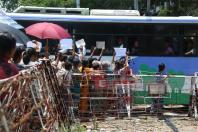As many of the world's nations prepare to get life back on track after the first brutal wave of the pandemic COVID-19, the developing nation of Myanmar is preparing to do the same.
While Myanmar's track record of COVID-19 cases has remained relatively low so far (158th in the Worldometers global rankings) with 260 confirmed cases, six total deaths and 165 recovered as of June 11, Myanmar's economy was slowing down even before the virus comatosed the globe.
Myanmar, as a developing country that relies on international trade and foreign investment, monetary or otherwise, and on sectors, such as manufacturing and export of garment, was severely rocked by this pandemic.
Economic wear-and-tear
As the first wave of COVID-19 picked up pace, countries started to implement rigid measures to keep out and keep in the infection. At the epicenter of the outbreak lies China, the biggest trade partner to Myanmar and to many other South-East-Asian nations.
Naturally, China was one of the first countries in the world to employ practices to reduce the spread of the Coronavirus, amongst which was the closure of all border trade and gates.
Myanmar's garment industry employs over approximately 700 thousand workers and accounts for nearly 10 percent of all exports. However, this industry relies heavily on China in the sense that most raw materials come from China and many garment manufacturing companies are owned by Chinese companies.
When Covid-19 struck, the garment sector sunk almost immediately.
In the three months, the garment sector saw the freeze of its supply chain, both locally and globally. As China and EU countries brace for impact, Myanmar found many of its textiles stockpiling up, many of its workers laid-off or given an indefinite 'rest' period, and factories closing up shop.
As many as nearly 60,000 garment labourers and an estimated amount of 200,000 workers in Myanmar's labour force found themselves retrenched.
The 2-billion committee
As signs show that infection rates are now at a manageable level, Myanmar looks toward its next, immediate challenge of restarting the economy. While organizations like the WHO continue to provide medical aid, groups like the EU have also pledged their support financially, such as the 5 million euro care package for Myanmar's garment industry workers, which was announced in April.
While that is a much welcomed move by the Myanmar government and the labour force, the integral part of any stimulation of the economy must come from local forces itself. Thus all eyes are on the promised 2 billion dollars, which is around 4 per cent of Myanmar’s GDP, that will be put forward from now on as the COVID-19 Fund, taken from the State's Revolving Fund and Social Welfare Fund.
Special Economic Consultant to the State Counsellor Professor Sean Turnell had also claimed on his Facebook post that the funds will also come from new concessional lending, innovative financing, domestic bond markets and budget reallocations.
The COVID-19 Fund will be used mainly to stimulate SMEs and the ultimate decisions for the direction will come from a committee formed on March 13 and chaired by Union Minister for Investment and Foreign Economic Relations U Thaung Tun.
The official tasks of the committee are to draw up both immediate and long-term remedial plans to treat the downturn of trade, tourism and other sectors hardest hit by COVID-19, such as the labour intensive construction sector.
It will also seek to alleviate over-reliance, such as the aforementioned garment sector, on one source while also creating new job opportunities as well as teaching the labour force more vocational skills to further diversify their expertise.
Despite many believing that the 2 billion dollars is a good step for the government to take, they are also afraid that there will be lesser or no more economy-boosting funds at all in the future.
The 2 billion is also diminutive when put in stark comparison against two neighboring states of India and Thailand with the former forking out 265 billion dollars and the latter 76 billion dollars.
Many are also skeptical that even the planning and policy making stages of the COVID-19 fund is lacking, calling it a temporary solution that is uncertain to even deal with the immediate hardships, let alone the far-reaching consequences.
Pouring salt on the wound
Even before the pandemic shut down the world, Myanmar's rising economy was already showing signs of slow down.
Although Myanmar approved a total foreign investment of over US$4,520 million in 2018-2019 fiscal year, an actual flow of investment from 28 countries amounted to just over US$2,766 million, according to a summary report on the activities of Myanmar Investment Commission during the period from October 1, 2018 to September 30, 2019. This is due to a myriad of factors.
One such is the lacklustre appeal of basic infrastructure that continues to cause power shortages, forcing business owners to invest in power generators, adding more to the running costs and compounding onto the list of reasons why investors may decide to either completely pull back or put a temporary hold to their ventures.
Plus Myanmar, and her de facto leader State Counsellor Aung San Suu Kyi, has fallen from grace in Western circles due to the northern Rakhine Crisis, a saga which has so far resulted in a case at the International Court of Justice against Gambia.
According to her,"The Covid-19 Economic Relief Plan will do its best to include all stakeholders and not leave anyone behind. The most obvious effect of Covid-19 is that the state will not receive the expected amount of taxes. Therefore the government need to reduce the allocated budget and spending and adjust according to the amount to be spent for Covid-19 relief plan. But with the current amounts, it will not be able to help achieve the socio-economic independence that many in the country are trying to achieve."
Of course, many foreign investors also decided to either roll back their investments or hold them back because they are also facing huge amounts of losses back in their home nations. Development of several major infrastructure projects such as the Yangon Elevated Expressway with a one billion dollars projected investment and the 10 billion dollars worth Dawei Special Economic Zone have been delayed.
There are many more that have been stalled across 12 economic sectors such as oil and gas, electricity, manufacturing, transport, communication, real estate, hotel and tourism, mining, livestock and fishery, agriculture, industry, construction and other services.
Limping to a running start
But it does not mean that these projects will not continue. Myanmar will, as it is usually the case of fast-developing nations, continue to have to rely on large swathes of foreign investment and there are plenty of them coming soon.
Many energy, sewage and other infrastructure projects exist in collaboration with the Japan International Cooperation Agency under a 1.1 billion dollar Japanese loan. South Korea is poised to proceed with projects such as the $154 million worth Yangon-Dala Bridge and Dala New City. China has announced that 22 projects under the Beijing-led Mekong-Lancang Cooperation Initiative will be funded with 6.8 million dollars while the Kyaukphyu Deep Sea Port worth at least 1.3 billion dollars remains a crucial part of China's Belt and Road Initiative.
"If we take only a glance at it, the state's economic plan looks feeble. But will it achieve high growth by just pouring in more funds? When do we stimulate it? For example, near to when the virus issues are close to being over or before it? How do we go about achieving it? It is a complex problem and in my opinion, no experts know what to do exactly. This is unprecedented and since it has never happened before, everyone is doing what they think and feel is the best way forward. It is too early to say what is wrong and right. Maybe they are right. Other countries are pouring in huge amount of stimulus but their economies are not getting better yet. If a lot was put in at the expense of damage to other budgets, when the next fiscal year comes, businesses may not have recovered and the government will receive even less taxes. It is a scary prospect to any government to be sure. In my opinion, it is a scarier scenario if a government just recklessly goes ahread with whatever they want to do" said Economic Consultant U Kyaw Myo Tun at a DVD Debate program.
As the major international projects continue, the question then becomes whether the people of Myanmar can keep up. According to official data, around 40 percent of families in Myanmar now live close to the edge of the poverty line. With over 170 factories shut down and many workers out of jobs, it will take more than a mere 2 billion dollars aid to cure the inevitable negative consequences of COVID-19 that will no doubt ravage, if not completely destroy, the lives of the common people.
Myanmar, especially in thriving hub cities like Yangon, can be said to have come back to life. But many owners of restaurants, bars, pubs and a whole slew of smaller businesses seem to share one same sentiment: COVID-19 may be deadly but poverty is a confirmed slow death.
The Ministry of Health & Sports reported on two more COVID-19 positive cases, with one notable patient being from Shan State that showed no international travel history. Such cases, until further details are clarified, is a sign of local transmission. Myanmar had for many weeks only reported new cases from people that had returned from abroad such as India.
As medical experts warn that countries must manage to a perfection each's "reopening" scenarios or risk stronger, deadlier second wave of COVID-19, Myanmar, and its current administration, must now not only look to facilitate foreign-funded projects to keep investments flowing in but also focus on restarting the economy and supporting the livelihoods of its citizens.










